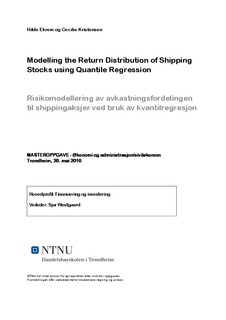Modelling the return distribution of shipping stocks using quantile regression
Master thesis

Permanent lenke
http://hdl.handle.net/11250/2409221Utgivelsesdato
2016-09-21Metadata
Vis full innførselSamlinger
- NTNU Handelshøyskolen [1564]
Sammendrag
This article models the risk profile of shipping stocks using the quantile regression approach. The method enables calculation and stress testing of Value-at-Risk (VaR) directly from the estimated conditional quantiles. Our research serves as an extension to existing research, as we are the first to model the relationship between shipping stock returns and a set of macroeconomic factors across the distribution of conditional returns. We regress the excess return of the portfolios for the container, dry bulk and tanker sectors, on the market portfolio excess return, the volatility index, and changes in the oil price, exchange rate and long-term interest rate. Our results show that factor effects differ across the conditional quantiles, implying that risk exposures vary under different market circumstances. This suggests that the standard regression may be inadequate to uncover the risk-return relation for shipping stocks. This is especially evident for the volatility index, the market portfolio return, and changes in the long-term interest rate. The results have implications for shipping investors who wish to add specific return characteristics to their portfolios, and allows for more informed portfolio adjustments. Moreover, we contribute to the empirical literature investigating tail risk in equity investments, laying the foundation for further research on the area. In the estimation of VaR we discover signs of asymmetric tail risk, with a higher exposure in the lower tail. Scenario analysis of VaR enables risk managers to consider how changes in macroeconomic factors will affect the risk exposure of shipping stocks, and can be helpful in hedging against various global factors.